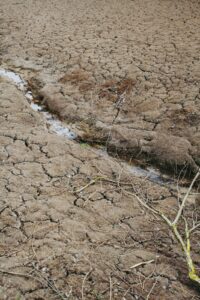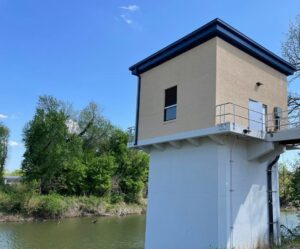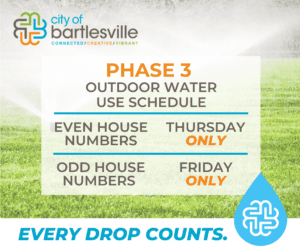
With the exception of steeper emergency water rate increases, Stage 3 of the Water Shortage Ordinance is in effect as of Monday, April 24.
Stage 3 limits outdoor water use to one day per week, drops the written warning for the first violation, includes reduced water pressure within the distribution system, and could later result in higher rates for households and businesses using more than 2,001 gallons of water per month.
“Implementing an increased fee schedule requires approval of a resolution by the City Council, so we will maintain Stage 2 rates for now,” said Water Utilities Director Terry Lauritsen. “If we are still in Stage 3 in early May, the council will be asked to approve the resolution for Phase 3 rates at that time.”
Stages of the ordinance are based on the percentage of overall water supply. Stage 1 kicks in when levels fall to 79-70 percent, Stage 2 is 69-60 percent, Stage 3 is 59-50 percent, and Stage 4, which is considered “critical,” is any level below 50 percent.
The City entered Stage 1 of the ordinance in December 2022, and overall water supply has continued to decline at a steady rate since that time.
As of Monday morning, the City’s overall water supply was at 57.4 percent, putting the area in Stage 3 of the Water Shortage Ordinance — just above “critical” status.
The forecast and other good news
Rain forecasted for this week is welcome news; however, even if it occurs as predicted, it is unlikely to change the situation much, Lauritsen said.
“The forecasted one-to-two inches may bump us up to around 60 percent, which would, of course, be welcome. But I believe we’ll need much more to end the drought,” he said.
Other welcomed news: Water consumption went down with the mandatory restrictions in effect, and the Caney River Pump Station is back online.
“After implementing the water restrictions for Stage 2 the week of April 10, water use shot up to 5.33 million gallons per day (mgd),” Lauritsen said. “Last week water use went down to 4.71 mgd. That shows that people are starting to take this issue more seriously and are doing their part to conserve.”


“It won’t change our overall water supply percentage, as lake levels can only be replenished by rainfall, but with further restrictions and the pump station allowing us to take 6 mgd from the Caney River, we should be able to meet usage requirements and preserve what’s left in the lakes for a longer period of time,” he said.
Hulah Lake is currently 43 percent full, while Copan Lake is 55 percent full. Bartlesville water users typically use about 4-5 mgd during the winter months, but that number can skyrocket during a typical summer, Lauritsen said.
“We can see usage in the 9-12 mgd range during the hotter months, which is double or even triple typical wintertime use,” he said. “This is due largely to irrigation and lawn maintenance and other outdoor water use. By limiting outdoor water use to one day per week for water customers, we can potentially save millions of gallons of water per day.”
What to do


- Rates increases (remain at Phase 2 rates) for customers using more than 10,000 gallons of water per month.
- 10,001 gallons and 25,000 gallons – 5 percent increase
- 25,001 gallons and 50,000 gallons – 10 percent increase
- In excess of 50,000 gallons – 15 percent increase
- Outdoor water use will be restricted to one day per week
- Even-numbered properties may water on Thursdays
- Odd-numbered properties may water on Fridays
- Water pressure will be reduced within the distribution system to minimum levels allowed by state and federal regulations
- City-owned facilities and capital projects will reduce or discontinue all irrigation except as necessary to preserve greens or newly planted trees. For athletic fields or newly laid sod or seed, the watering shall be restricted to follow the outdoor water restrictions for even numbered properties implemented by each stage.
- A reduced schedule of operation or closure may be implemented for City-owned swimming pools.
- City-owned splash pads will remain closed.
- All leaks in the raw water and treated water system will be repaired immediately, and non-essential operational uses of water by City crews will be suspended. This includes the flushing of water mains and fire hydrants, street sweeping, routine water jet cleaning of sanitary sewer mains, and non-essential training of fire fighters using potable water.
A variance committee is in place to consider cases of undue hardship for the emergency rates.
“Anyone who feels these provisions place an undue burden on them, their organization or business can seek a variance,” Lauritsen said.
To apply for a variance, complete the “Contact Us” form on the City’s website, www.cityofbartlesville.org, or call 918.338.4100. Variances apply only to emergency rates and do not apply to outdoor water use or any other provision in the ordinance.
Some ways you can help:
- Take shorter showers. This is the No. 1 most effective thing we can do (indoors) to conserve.
- Consider installing “low flow” plumbing, i.e., toilets, shower heads, etc. Also, replace any leaky or defective parts.
- Turn off the tap while brushing your teeth or shaving.
- Never use the toilet as a wastebasket. Only human waste and toilet paper should go into the toilet — ever.
- Run the washing machine only when full and adjust the water level setting carefully.
- Stop or reduce outdoor watering.
For more information, see www.cityofbartlesville.org.
